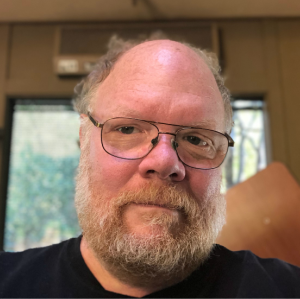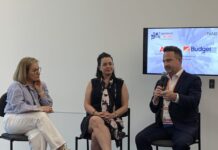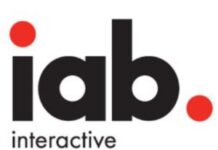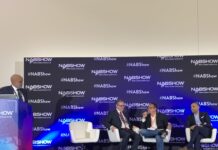
Roger Coryell is the Managing Partner at Brandhound Destination Marketing in Sonoma County. Coryell actually started in radio back in 1973 doing mornings and as working APD at KKSF San Francisco. That’s where he discovered digital and helped build the first radio station website and did email marketing and banner sales for radio. He also worked at KFOG and led Bay Area digital efforts for Bonneville, then Disney and Citadel. We reached out to Coryell to ask him to give us his unique perspective on the radio industry now, from the other side.
Radio Ink: Why did you leave radio?
Roger Coryell: I’ll probably never really leave radio. I have my hand in community broadcasting, podcasting, streaming, voice acting. But I left my last radio management position because I saw better opportunities in the real world. My radio mentors, people like Dave Kendrick, Chuck Tweedle, and Mickey Luckoff, encouraged me to learn and grow as a marketer and manager, and working for a bankrupt corporate media company no longer provided those opportunities for professional growth.
Radio Ink: Are you happier outside radio?
Roger Coryell: My days as a broadcaster were a wonderful part of my life. There were some rough moments, but we did good work, had a lot of fun, made a difference in the community. But I don’t miss it. And I only get “the dream” every year or so.
Radio Ink: What do you see from the outside, as opposed to being on the inside (of radio)?
Roger Coryell: I live and work in an area that is prone to catastrophic floods and fires. Local radio operators come through with flying colors. The culture of agility and public service that I thought was gone is still alive and well. I am proud of my radio friends in Sonoma, Napa, Lake, and Mendocino counties who have proven that radio is a vital resource to our region. But on a nice day, with no emergency, radio just isn’t very important to most people. Especially younger people. Media is important. Audio is important. Storytelling is important. Advertising, which lubricates our economy, is important. Localism is an important opportunity. But “radio”? Nope.
Radio Ink: What are radio’s biggest problems through the eyes of an agency executive?
Roger Coryell: Poor measurement that lacks credibility, long spot clusters that create a bad environment for terrestrial radio ads. Poorly trained sellers (although I can think of notable exceptions). Poor execution (again, there are notable exceptions).
Radio Ink: Do you still use radio for your clients and is it working?
Roger Coryell: Yes, and yes, when I can convince the client to use radio as part of a campaign.
Radio Ink: Do you believe the numbers radio executives throw around regarding radio’s ROI?
Roger Coryell: Nope. I believe, strongly, that radio can be very effective when used right, as part of a cross-media campaign, for both direct response and branding. But what I hear from radio executives is fluff.
Radio Ink: What advice do you have for your old radio friends?
Roger Coryell: Invest in credible measurement technology, and training. Get rid of Nielsen, or hold them to a much higher standard. Whatever the solution, it’s going to cost more.
Invest in training. Encourage sellers to learn more about the measurements that matter to your clients, and how to move those measurements. For example, if you’re selling into the travel and tourism space, familiarize yourself with the STR report. Give the sellers the training and tools to be real marketing solution providers. This MUST include digital. Radio and digital are a powerful combination initiating trackable conversations between brands and customers.
Be willing and able to create solutions that are not limited to a given media company’s menu of in-house offerings. Invest in more compelling content. Take a clue from the wine industry. Wineries sell product two ways: through a convoluted and expensive tiered distribution system, and through much more lucrative direct-to-consumer sales. The key to the D2C revenue is carefully nurturing a personal, face-to-face branded relationship with consumers, including tasting rooms, experiential marketing, loyalty programs, segmented personalized email marketing, key partnerships. This is all stuff I learned how to do in radio.
Tourism? Same thing. It’s about building user personas, identifying your audiences, figuring out how to reach them, touching them repeatedly with a consistent message, compelling stories, and a call to action. Then we get permission to market to them and follow that path. We identify the aspirational traveler, we build the relationship, we influence behavior. Digital gives us tools that help us do that very effectively, and measure our efforts so we can iterate.
I would steer away from industry-specific vertical solutions for building and tracking relationships with your listeners and advertisers and connecting them. Most of the radio-centric vertical solutions are 10 years out of date. Live in the real world.
Radio has brilliant researchers. You know this stuff. Use it to help your clients.
Radio Ink: Is radio where it needs to be in the digital space?
Roger Coryell: Absolutely not. I still hear the same questions from market managers that I was listening to at Eric’s digital events in 2000. I still see the same insular sales culture and a “not invented here” bias in large groups.
Radio Ink: How can radio be better at digital?
Roger Coryell: PLEASE PLEASE get rid of the clunky crappy spot replacement in your terrestrial streams.
Radio Ink: Is radio taking podcasting seriously? Should it?
Roger Coryell: This is one of the bright spots I am seeing. Podcasting is a very cool medium, and listeners are embracing it. Radio has always been about storytelling and curation and brand building. Radio has very talented audio producers. You know how to do this. Own it!
Reach out to Roger at [email protected]






Roger, as a 35-year former radio guy, emphasis on former, I must say, I think you nailed it.
Roger – many thanks for your insights. Wanting to know what to do/what NOT to do – and with whom- please expand on/describe in more detail, the type of solutions to which you refer, and viable alternatives re your comment “steer away from industry-specific vertical solutions for building and tracking relationships with your listeners and advertisers and connecting them. Most of the radio-centric vertical solutions are 10 years out of date”.
Andy: that’s a tough one to answer in a forum like this. Shoot me an email at [email protected] and we can maybe get more specific.
Because he’s been on my mind lately, I’ll cite the late Paul Harvey as an example of compelling content combined with mastery of spoken-word communication skills. Were he on the air today, it is unlikely that he would need any help from the digital space to maintain meaningful listenership or to get results for his sponsors, who would still be waiting in line for a spot on his shows. He might add podcasting to his toolkit to extend his reach, but that would be entirely at his pleasure and not because he needed it to survive. Radio’s future lies not in being a better jukebox, but in providing opportunities for talented communicators to speak something of value to our audiences.
Agreed.
Hey Roger! Long time listener to your show, back on KKSF; first time caller.
Great to read what a great radio voice & mind is now up to. 🙂
Hi Doc!
“Radio appeals to younger demos, it remains the primary source of music discovery”
Your kidding with this statement, right? Do you actually know anyone in these “Younger” demos? Try spending time in a classroom with this demo and you will quickly learn that NOBODY is discovering new music on the radio. Spotify, YouTube, SoundCloud- Yes, Yes, Yes. Radio-Absolutely NOT. The first step in fixing an issue within an industry is admitting that you have a problem.
Steve: Agreed. It’s a crock.
The problem with Spotify, YouTube, Pandora, and SoundCloud is the listener has to do the work and seek out the new songs. Sure they’re there, and there are lots of new songs and new artists. But that’s not always the motivation behind their search. So recording artists and their record labels still consider broadcast radio as a better way to introduce audiences to new music, and they devote millions of dollars to accomplish that. Ask any recording artist what they’d prefer: OTA airplay or a song on Pandora. They prefer the airplay, because it translates to visible audience recognition.
I’m a music junkie. I use Spotify and Pandora and podcasts and YouTube for music discovery. And Sirius/XM. So do most people. Sure, radio is part of the mix. But we have lots of choices
Not disputing choices. Sirius may be better than streaming, because their music shows are hosted, but only a fraction of people use it because it’s subscription. While lots of people stream, they don’t use streaming as much for discovery, and I can cite streaming charts to prove it.
100% not true. Spotify has “discover weekly” which is one of their most popular features and I find new artists and songs on Pandora all the time. Pandora even owns “next big sound” which tracks up and coming /trending artists. Radio does not even come close to the personal discovery streaming can provide. Personally, I love NPR and sports content on radio, but radio lost me for music long ago due to long stop sets and a lack of musical options. Aka, crappy content. Reggae? Nope. Jazz fusion? Radio plays the same, tired songs over and over. Go tune to your loca CHR/Top 40 station and you will quickly find that out. Too many people in this industry have their blinders on. Just look at the comments from the defensive industry execs reading this article. “Radio is first in discovery for young people?” Get a grip!! Go walk a college campus, or even scarier a Hugh school campus, and ask those kids how much radio they listen to. Maybe a few needles in that haystack, but the results won’t be pretty. Whoever said that can Sell crazy somewhere else. We’re all stocked up here.
outside of the #1 complaint about SiriusXM’s audio sounding like crap
the #2 complaint…they play the same songs!
Edison Research actually asked people about new music discovery, and the top answer was FM radio. As I said, there are lots of choices, so nobody has 50%. FM radio has 20%, Pandora has 9%, Spotify has 7%, etc. How many people want to hear reggae or jazz fusion? Obviously not many. Any songs that are trending high online are getting played on air. The record labels use that information in their pitch to get their songs played. Radio plays the same songs, and so does Pandora if that’s what you want to hear. Remember, all of the songs people play online show up in charts, so we can see what people listen to. The songs radio plays are also getting played the most by online services. No difference.
Just one example, I have a teenager who uses radio to find artists and then goes to Spotify to get more from that artist. When the radio plays a song, the listener didn’t pick that song, they are sort of forced to try it out. If they like it they keep listening, then inquire who the artist is and then uses digital music to add that artist to music they like. Yes there are more choices these days but radio is still first in discovery.
Spend money on Radio Creative and folks will add it back to daily connection and routine enjoyment!
If all we have left to market to via radio is 40+ I’ll take that! They are living longer, have more disposable income, are actively seeking entertainment and information with an affinity towards radio. Time to treat commercials like local info opps and not some shouting ego based blather. We’ve just added four millennials to our staff. THEY see a future in local radio.
Radio’s measurement is the same as TV. Radio’s spot clusters are half the length of Cable’s. The measurement system is far more reliable than the crooked bot rigged numbers from diigital ie Faceook phony numbers, Twitter phony followers. Get rid of Nielsen, I hate them and agree, but we would have to get ABC, CBS and NBC to buy in!! Agree on all his points except radio’s appeal to younger demos. Radio appeals to younger demos, it remains the primary source of music discovery.
No doubt that radio can work, given a chance, and done right. But radio ratings have a tiny sample size and fundamentally suspect methodology. Yes, there are some interesting attribution tools. And successful DR advertisers know how to do their own attribution tracking. But most sellers don’t know how to even start that conversation. And many advertisers simply won’t go there.